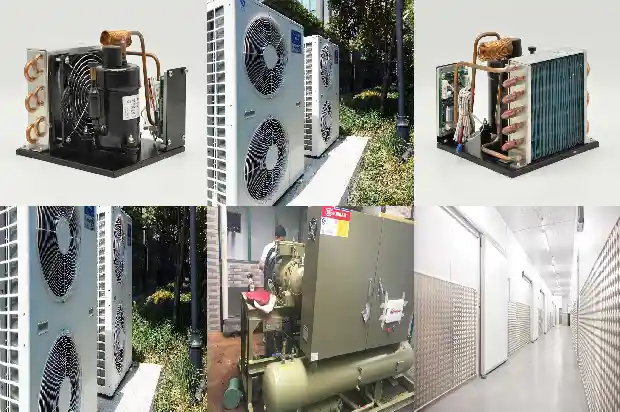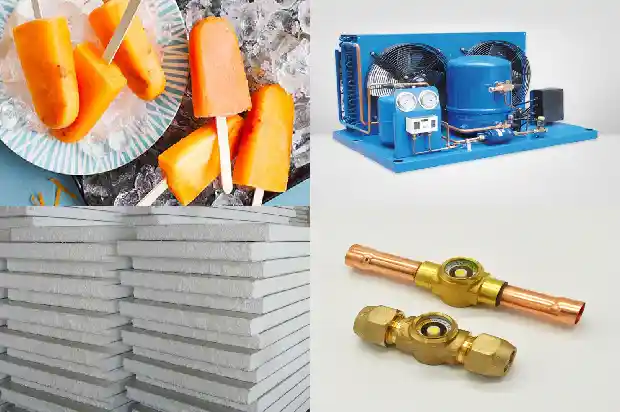Four Major Components of an Air Conditioner: Principle, Structure, Adjustment and Faults of the Expansion Valve
2025-04-24
The air conditioning system has four major components: the compressor, the condenser, the evaporator, and the throttling component. Recently, we talked about the throttling component, and today we will share the relevant knowledge about the expansion valve.
Thermal Expansion Valve
- Principle and Structure of the Thermal Expansion Valve
The thermal expansion valve can control the injection of liquid refrigerant from the condenser into the evaporator. The expansion valve can keep the superheat degree at the outlet of the evaporator at a certain level, preventing the liquid refrigerant from leaving the evaporator and entering the compressor. Once the liquid refrigerant enters the compressor, liquid slugging will occur, and this situation must be prevented to avoid damage to the compressor. - Pb - Bulb Pressure
- Pe - Evaporation Pressure
- Ps - Spring Pressure
- Pb = Ps + Pe, the diaphragm does not move.
- When the bulb pressure rises, causing Pb > Ps + Pe, the diaphragm moves downward, the valve opens, and more refrigerant flows into the evaporator.
- When the bulb pressure drops, causing Pb < Ps + Pe, the diaphragm moves upward, the valve closes, and the refrigerant flowing into the evaporator decreases.

- Adjustment of the Thermal Expansion Valve
Adjustment Principles: - Do not adopt a drastic adjustment method during the adjustment;
- For the scattered gear type, a small gear drives a large gear, and the number of adjustment turns is relatively large. Generally, it can be adjusted 2 - 4 turns (usually, when the outer adjustment rod rotates 4 turns, the inner scattered gear only rotates 1 turn)
- The adjustable number of turns of the press rod type is relatively small. Try to adjust it according to one-half, one-third, or one-fourth each time.
- Each time the expansion valve is adjusted, it generally takes 15 - 30 minutes;
Adjustment Precautions:
The debugging of the expansion valve must be carried out carefully and patiently. The adjustment pressure must go through the heat exchange boiling (evaporation) between the evaporator and the temperature of the cold storage and then enter the suction chamber of the compressor through the pipeline and be reflected on the pressure gauge, which requires a time process. Each time the expansion valve is adjusted, it generally takes 10 - 15 minutes for the adjustment pressure of the expansion valve to stabilize on the suction pressure gauge. The adjustment should not be too hasty. The suction pressure of the compressor is the main parameter basis for adjusting the pressure of the expansion valve.
Specific Operations: - If the outlet side and the lower part of the expansion valve body are frosted in a 45-degree oblique shape, and the inlet side should not be frosted, it indicates that the adjustment is accurate and appropriate.
- If the frost shape does not change when adjusting it larger, it may be that the throttling hole of the expansion valve is partially blocked and must be cleaned. There should be no moisture during cleaning, otherwise, ice blockage may occur.
- If only the outlet side of the expansion valve is frosted, it indicates that the flow rate is too large and should be adjusted smaller, that is, adjusted in the counterclockwise direction to loosen the spring.
- If the entire expansion valve body is frosted, it indicates that the flow rate is too small and should be adjusted larger, that is, adjusted in the clockwise direction to compress the spring.
- If only the inlet side of the expansion valve body is frosted, it indicates that the filter screen at the inlet of the valve body is partially blocked and should be cleaned.
- If there is no frost on the expansion valve body at all, it indicates no flow. The reasons may be that the refrigerant has leaked out completely or there is a valve in the pipeline that has not been opened; the bulb probe or the capillary tube of the expansion valve is leaking; the filter screen at the inlet of the valve body is partially blocked and should be cleaned; the throttling hole of the expansion valve is blocked.
- It is also possible to judge whether the adjustment is reasonable by observing the change in the frost shape on the suction pipe of the compressor:
7.1 If the white frost is at the suction stop valve, it indicates that the flow rate is too large and should be adjusted smaller.
7.2 If the white frost is on the suction pipe, it indicates that the flow rate is too small and should be adjusted larger. - Judge whether the adjustment is reasonable according to the magnitude of the pressure value on the low-pressure side.
- Judge whether the adjustment is reasonable according to the uniform and complete condition of the frost on the evaporator coil.
- Under normal circumstances, the expansion valve operates quietly. If a relatively obvious "hissing" sound is emitted, it indicates a lack of refrigerant.
Electronic Expansion Valve
- Principle of the Electronic Expansion Valve
The electronic expansion valve is a throttling element that can adjust the refrigerant flow rate entering the refrigeration device according to a preset program. It adjusts the liquid supply amount to the evaporator according to a preset program. Since it belongs to an electronic adjustment mode, it is called an electronic expansion valve.
The motor rotor uses a permanent magnet. The interaction of attraction and repulsion between the magnetic field generated by the rotor and the magnetic field induced by the stator winding makes the rotor rotate.
The pulse motor is controlled by a microcomputer. The microcomputer sends control instructions, applies a pulse voltage to the stator winding of the motor, and drives the rotor to act. When the command signal sequence is reversed, the motor rotates in the reverse direction. Therefore, the pulse signal can control the forward and reverse rotation of the motor, move the regulating valve rod up and down, change the valve needle opening, and achieve flow rate adjustment.
The electronic expansion valve and the variable frequency speed regulation of the compressor cooperate with each other, and uninterrupted heating and rapid defrosting can be achieved. During defrosting, the four-way valve does not change direction, the electronic expansion valve opens to the maximum, the compressor runs at a high speed, the refrigerant circulates in a large flow rate, and the heat of the compressor exhaust is used for defrosting. In this way, the defrosting time is short, the additional energy consumption for defrosting is reduced, and the heating efficiency is not affected.
Control the discharge temperature of the compressor. When the discharge temperature is too high, increase the opening degree of the electronic expansion valve, increase the refrigerant flow rate, cool the intake air, and thus reduce the discharge temperature.
Reduce the energy loss during the start and stop process in the start and stop control of the compressor. When the compressor stops, the electronic expansion valve can make the valve in a fully closed state to prevent the refrigerant from flowing from the condenser to the evaporator; when the compressor starts, first control the electronic expansion valve to open, so that the suction and discharge pressures quickly reach equilibrium, and then control the compressor to start. In this way, not only the heat loss is reduced, but also the compressor is easy to start. - Composition of the Electronic Expansion Valve
- The electronic expansion valve is mainly composed of four parts:
1.
1 Rotor: It is equivalent to the rotor of a synchronous motor, and it is connected to the valve rod to control the opening size of the valve hole.
1.2 Stator: It is equivalent to the stator of a synchronous motor; it converts electrical energy into a magnetic field to drive the rotor to rotate.
1.3 Valve Needle (Core): Driven by the rotor, its end is conical, and it moves up and down for flow rate adjustment.
1.4 Valve Body: Generally made of brass.
However, from the perspective of control implementation, the electronic expansion valve is composed of three parts: the controller, the actuator, and the sensor. The core hardware of the electronic expansion valve controller is a single-chip microcomputer. - Composition of the Electronic Expansion Valve Control System:
2.1 Electronic Expansion Valve Body;
2.2 Controller;
2.3 Pressure Sensor;
2.4 Temperature Sensor. - Classification of Electronic Expansion Valves
According to the driving method, there are two types: electromagnetic type and electric type.
Currently, the most commonly used one is the electric electronic expansion valve driven by a four-phase stepper motor. The electric type is further divided into direct-acting type and reduction type.
The direct-acting type is when the stepper motor directly drives the valve needle, and the reduction type is when the stepper motor drives the valve needle through a gear set reducer. The electric electronic expansion valve uses a motor to directly drive the shaft to change the valve opening. - Fault Judgment of the Electronic Expansion Valve
- The valve of the electronic expansion valve is in a fully closed state:
Normally, before the electronic expansion valve is powered on, the needle valve is in the open position. The valve opening of the valve body when it leaves the factory is 480 pulses. However, since the rotor is fixed through a threaded structure, the position of the rotor may change due to vibration during transportation, and finally, the valve is in a fully closed state.
In case of this fault, a reset operation should be carried out after powering on to ensure that the valve body is in the open state, so that the opening size of the needle valve can be controlled by the stepper motor, and thus the flow rate of the expansion valve can be adjusted. - There is noise inside the electronic expansion valve after starting up:
If the noise is too loud, it indicates that the internal components are stuck, and the whole device needs to be replaced to solve the problem. If there is a "click" sound in the valve body when the power is turned on, this is a normal phenomenon. After the air conditioner is powered on, the electronic control board will send a full-open or full-closed pulse to the electronic expansion valve. At this time, when the rotor of the electronic expansion valve rotates to the maximum opening, it collides with the limit device and emits a "click" friction sound. When the air conditioning system is filled with refrigerant, the resistance to the rotation of the rotor increases and the sound propagation mode changes, the operation sound of the electronic expansion valve will become very small. - The electronic expansion valve does not act:
When the power is turned on, first listen for a "click" sound in the valve body. If there is no sound, check whether the valve body is fully inserted into the coil, whether the connection between the coil and the circuit board is normal, and whether the power supply voltage of the coil meets the requirements (12V ± 1.2V).
If the above inspections are all normal, then check whether the valve body can be fully opened. If not, it indicates that the valve body is damaged and needs to be replaced. If the valve body can be fully opened, then check whether the number of full-closed pulses of the valve is greater than 480pps. If it is lower than 480pps, then check the drive mechanism. - The electronic expansion valve is stuck:
This fault is caused by debris entering the interior of the electronic expansion valve and accumulating when the refrigerant flows. When the debris is embedded in the valve body, the friction force for the rotation of the rotor will increase, causing the stuck phenomenon. Usually, only the whole device needs to be replaced to solve the problem.
Common debris includes pipeline foreign matter, welding oxides, etc., that is, most of the faults are caused by human factors. To prevent this fault, during maintenance:
4.1 Strengthen the cleanliness of the pipeline;
4.
2 Adopt welding protection, generally by filling with chlorine gas to reduce oxides;
4.3 Install a filter with more than 100 meshes at both ends of the valve body.
Related Articles
- Basic Knowledge of Valve - type Components in Refrigeration Systems (Technical Sharing)
- Relationship and Adjustment between the Four Main Components of a Refrigeration System and Refrigeration Capacity
- Do You Know All the 34 Components of the Air-cooled Multi-connected Unit?
- Installation Precautions for the Source Components of Automatic Instruments in Refrigeration Units
- Several Key Components on the Oil Circuit of the Refrigeration System
- HVAC - Common Auxiliary Components of the Refrigeration System
- Analysis of the Main Functions and Components of Refrigeration Air Conditioners
- Analysis of Common Auxiliary Components in the Refrigeration System One by One
- Advantages and Disadvantages of Air-cooled Multi-connected Units and Analysis of Their Components
- Do You Have a Thorough Grasp of All 34 Components and Functions of the Air-Cooled Multi-Split System?
- Analysis of Common Auxiliary Components in the Refrigeration System
- Refrigeration Components of Refrigeration
- Principles, Components and Heat Recovery of Modular Units
- Basic Knowledge of Valve - type Components in Refrigeration Systems (Technical Sharing)
- Analysis of 6 Components in Air - cooled Multi - split Systems
- Analysis of Advantages, Disadvantages and 34 Common Components of Multi - split Air Conditioners
- Are you familiar with the detection and maintenance methods of air conditioner components?
- Top Ten Components of Refrigeration Systems and Five Common Troubleshooting!
